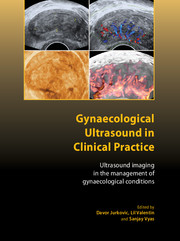 Gynaecological Ultrasound in Clinical Practice
Gynaecological Ultrasound in Clinical Practice Book contents
- Frontmatter
- Contents
- About the authors
- Abbreviations
- Preface
- 1 Ultrasound imaging in gynaecological practice
- 2 Normal pelvic anatomy
- 3 The uterus
- 4 Postmenopausal bleeding: presentation and investigation
- 5 HRT, contraceptives and other drugs affecting the endometrium
- 6 Diagnosis and management of adnexal masses
- 7 Ultrasound assessment of women with pelvic pain
- 8 Ultrasound of non-gynaecological pelvic lesions
- 9 Ultrasound imaging in reproductive medicine
- 10 Ultrasound imaging of the lower urinary tract and uterovaginal prolapse
- 11 Ultrasound and diagnosis of obstetric anal sphincter injuries
- 12 Organisation of the early pregnancy unit
- 13 Sonoembryology: ultrasound examination of early pregnancy
- 14 Diagnosis and management of miscarriage
- 15 Tubal ectopic pregnancy
- 16 Non-tubal ectopic pregnancies
- 17 Ovarian cysts in pregnancy
- Index
8 - Ultrasound of non-gynaecological pelvic lesions
Published online by Cambridge University Press: 05 February 2014
- Frontmatter
- Contents
- About the authors
- Abbreviations
- Preface
- 1 Ultrasound imaging in gynaecological practice
- 2 Normal pelvic anatomy
- 3 The uterus
- 4 Postmenopausal bleeding: presentation and investigation
- 5 HRT, contraceptives and other drugs affecting the endometrium
- 6 Diagnosis and management of adnexal masses
- 7 Ultrasound assessment of women with pelvic pain
- 8 Ultrasound of non-gynaecological pelvic lesions
- 9 Ultrasound imaging in reproductive medicine
- 10 Ultrasound imaging of the lower urinary tract and uterovaginal prolapse
- 11 Ultrasound and diagnosis of obstetric anal sphincter injuries
- 12 Organisation of the early pregnancy unit
- 13 Sonoembryology: ultrasound examination of early pregnancy
- 14 Diagnosis and management of miscarriage
- 15 Tubal ectopic pregnancy
- 16 Non-tubal ectopic pregnancies
- 17 Ovarian cysts in pregnancy
- Index
Summary
Introduction
Ultrasound is a versatile diagnostic tool that is of proven value in the assessment of women with gynaecological complaints. Transvaginal ultrasound has improved the ability of ultrasound to interrogate the pelvic organs with less interference from intervening structures such as gas or fat. However, it is not only the uterus and ovaries that are amenable to ultrasonic inspection. Other pelvic structures such as the bowel, renal tract or pelvic sidewalls are also readily seen. This is fortuitous, as symptoms arising from the pelvis are relatively nonspecific. The gynaecologist may, for instance, need to distinguish between the symptoms caused by pelvic inflammatory disease and those of an inflamed pelvic appendix. An awareness of alternative diagnoses and an appreciation of the normal and abnormal ultrasound appearances of bowel, bladder and other structures will help in achieving the correct diagnosis.
Transvaginal ultrasound, because of the ability to place the probe close to the region of interest, can better enable the diagnosis of pelvic disease. It allows an imaged bimanual palpation to occur, with the movement of tissues relative to each other seen and tender structures found. This can remove doubt so that other imaging modalities such as computed tomography (CT) are not needed. Transvaginal ultrasound also facilitates diagnostic and therapeutic intervention in the pelvis: guided needle biopsies or drainage of collections can all be achieved. This chapter aims to encourage the gynaecologist to look beyond the uterus and ovaries when imaging the pelvis.
Keywords
- Type
- Chapter
- Information
- Gynaecological Ultrasound in Clinical PracticeUltrasound Imaging in the Management of Gynaecological Conditions, pp. 77 - 90Publisher: Cambridge University PressPrint publication year: 2009


